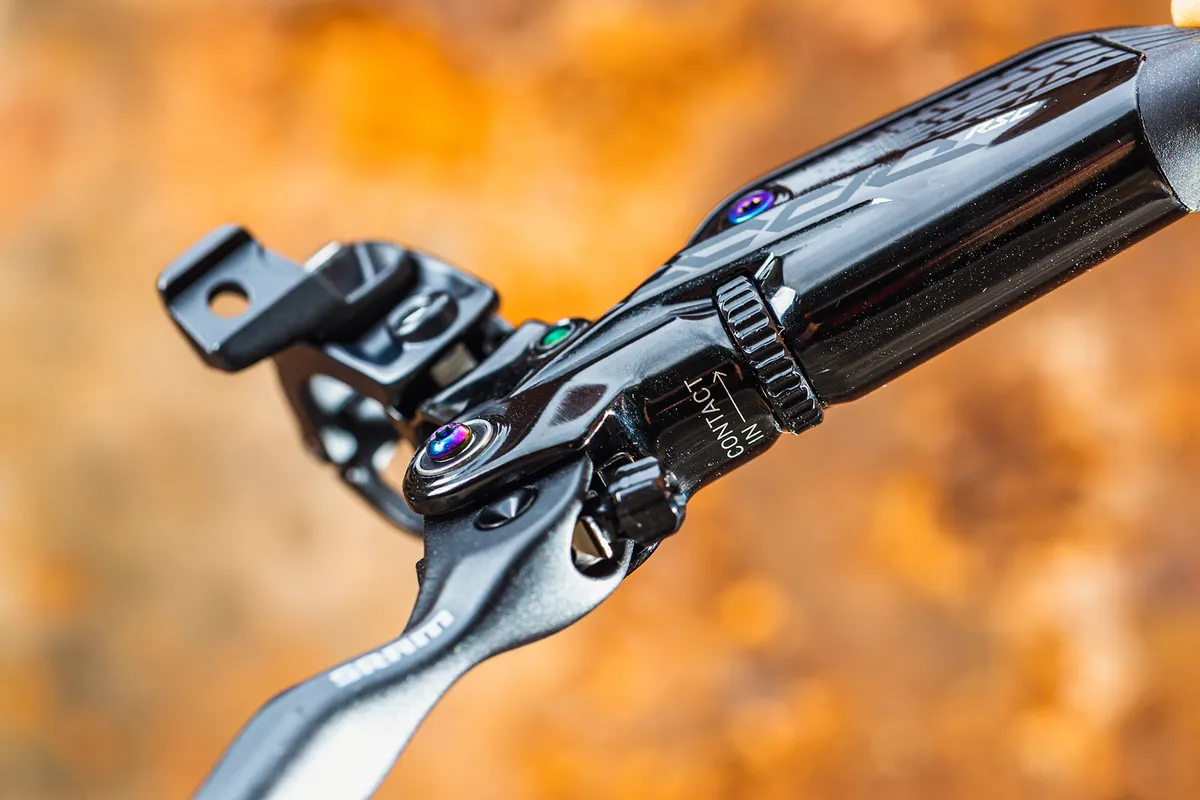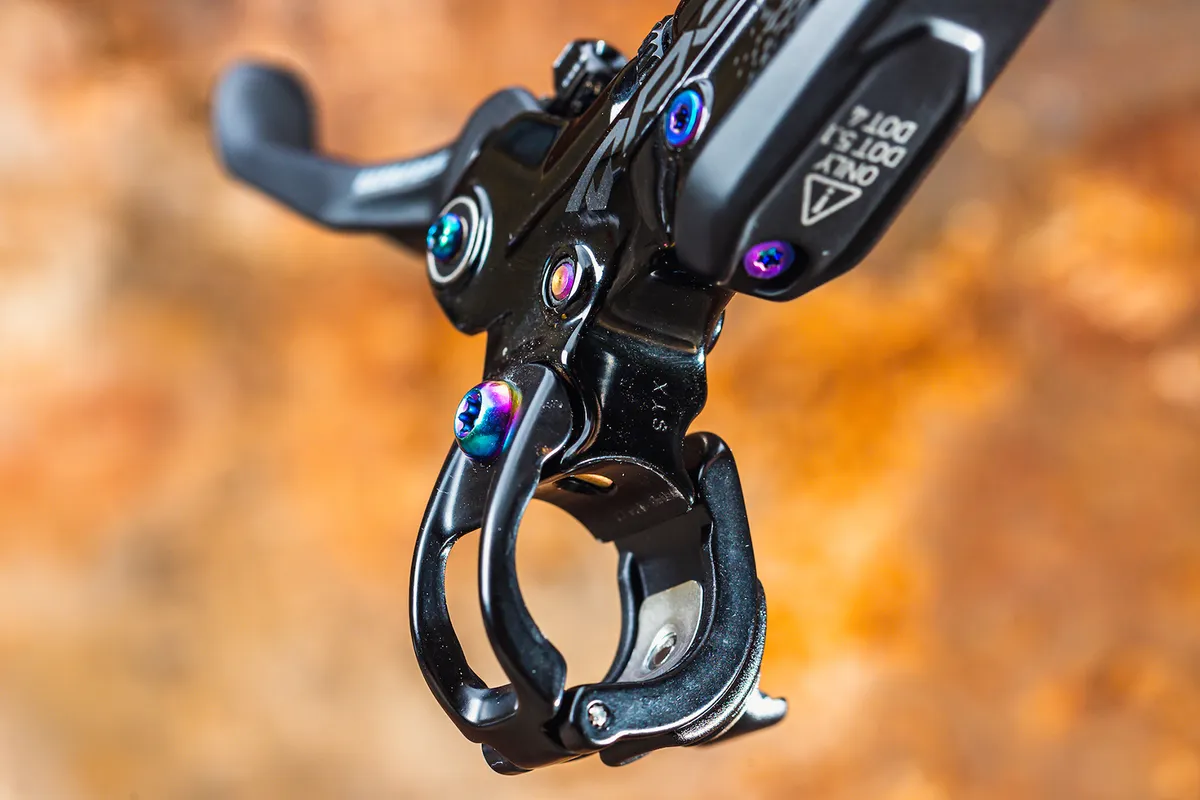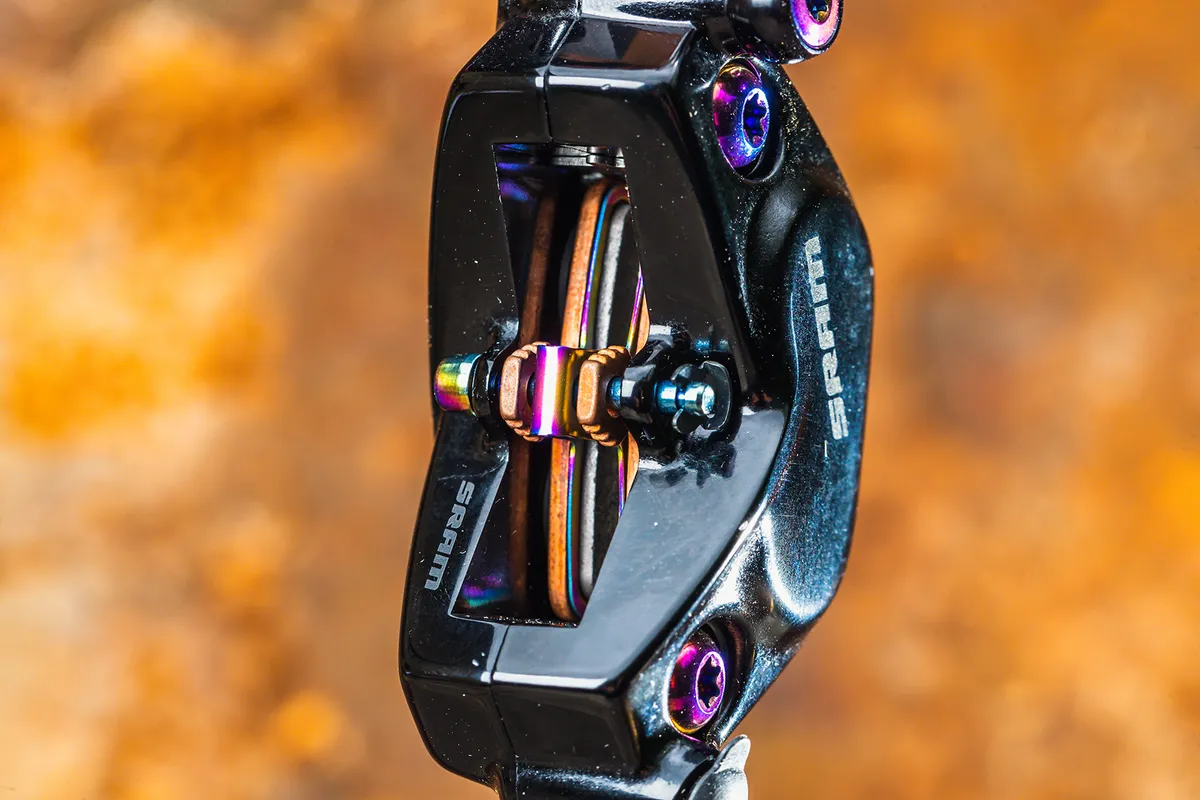The Code is one of the most popular brakes between the enduro and downhill tapes – it’s SRAM’s flagship big-power brake, so that’s no real surprise.
This RSC version of the brake not only features extra adjustment over the Code R, but also comes with some very fancy looking oil-slick finished hardware.
SRAM Code RSC disc brakes specification and detail
Like SRAM’s other brakes (SRAM G2 and Level), the Code gets a flip-flop style lever, allowing it to be run on either side of the bar, without needing to swap the hoses over.
Add in the detachable hinged bar clamp and it’s a super versatile lever in terms of handlebar fitment. The clamp holds SRAM’s MatchMaker shifter and Reverb holder if you’re running that. Obviously, there’s no official Shimano shifter holder, but aftermarket options exist.
Being both hinged and removable (the brake lever itself is clamped between the hinged section of the clamp), fitting to the bar can be a bit of a juggle getting the three holes and the bolt all matched up and engaged.

The lever has tool-free adjustment for both the lever position and the bite point. The bite point adjuster wheel is sunk into the reservoir body, making it a touch harder to access than a dedicated external dial would be, and in my experience, it doesn’t offer a huge range of adjustment – though this can be a little brake dependant in some cases.
The lever body is solidly built with a nice, premium finish – smoothed corners, no sharp edges, no lever rattle and bearings rather than bushes at the lever pivot.
The lever houses SRAM’s SwingLink linkage, which provides a quicker relative movement of the pistons early in the stroke to get the pads to the rotor, and then backs this off to give increased modulation as you squeeze the lever.
The reservoir is larger than the previous version of the Code, meaning more fluid volume and slightly more heat resistance.
At the caliper end, the two-piece unit holds four pistons and a large single pair of pads, secured by a screw-in pin and safety clip. The pistons have slightly different diameters, which impacts on how the pads hit the rotor as well as brake feel.
SRAM claims that their increased diameter over the previous version increases power by 15 per cent. Between the pads and the caliper body is a heat shield, to give a little extra insulation between pad and fluid.
Hoses exit the calipers via an adjustable banjo to help get cable routing right. Mine came with a 950mm hose at the front and a 1,950mm hose at the rear – long enough for most extra-large bikes.
My only gripe with the calipers' architecture is that the rear of the piston housing overhangs slightly where the lower bolt goes.
As such, I found a ball-ended Allen key the easiest to use, but scuffed the calipers' paint while fitting the brake in tight rear triangles – you’ll need to check your multi-tool has sufficiently long bits to clear the caliper body if you need to make on the trail adjustments.

Bleeding the brakes is very easy with SRAM’s Bleeding Edge tool. This pair of syringes includes a push-in nipple on the end of the caliper syringe. The process has more steps than most bleed processes, but they’re easy to follow and I achieved a decent bleed first time round.
The full pro SRAM Bleed Kit with Bleeding Edge Tool is fairly expensive, but parts can be sourced individually and aftermarket versions are also available.
I especially like the screw-in barb and screw-on olive, which make cutting and re-fitting hoses easy, especially if you don’t have a tool such as the Park Tool Hydraulic Barb Tool.
SRAM Code RSC disc brakes performance
The Code offers power by the bucket load, a testament to the fact that it’s consistently found on enduro, DH and electric MTBs.
The brake has SRAM’s customary modulated feel, with a smooth, linear progression in its power as you squeeze the lever. The initial bite is present, but slightly muted compared to a Shimano brake – so you won't worry about the power on offer when you first squeeze the brake and won't be ejected over the front of the bike due to an over-enthusiastic rotor grab.
This means you enter technical sections with confidence, whether that’s through the ease at which speed can be scrubbed or because you know you can control your speed to the finest margins down steep, tight tracks.

Getting to the absolute limits of the brake’s power is easy to achieve thanks to a reasonably long lever – this means you’re not having to squeeze your fingers too hard to get the best from the brake, so less arm pump, too.
On longer descents, power and feel are consistent, suggesting the brakes deal well with heat build-up.
The Code RSC doesn’t have the lightest lever feel going, with a hint of resistance, but it’s not to the same extent as that found with Shimano or Hope offerings.
SRAM Code RSC disc brakes bottom line
SRAM's Code has an enviable reputation for good reason. Simply put, the Code RSC offers as much power as any other brake on the market, with excellent feel, top-quality construction, wide-ranging adjustability and easy maintenance.
For this reason, it’s my top-rated enduro and DH brake in 2021.
How we tested
We rounded up 12 powerful hydraulic brakes to find out which are the ultimate speed-scrubbers.
To get to know what it’s like to live with these brakes, we asked the brands to send us their official bleed kit, then trimmed the hoses to our ideal length.
As such, we’ve cut and bled every set we tested to see just how easy they are to maintain. Then we saddled up to see how they performed on the trails.
Overall braking power is important, but so too is the ease with which you’re able to access that power – if you have to squeeze the lever really hard, that’s likely to lead to arm pump. Brake ‘feel’ is another key aspect – it’s subjective, but some people like a really grabby feel, while others prefer the power to progressively build as you squeeze the lever. We also needed to work out just how powerful the brakes are, and how resistant to heat build-up.
So, with the help of both leg power and some electrical assistance, we took them to the top of some of the South West’s steepest slopes and pointed our bikes downhill to see how these 12 stoppers coped.
Note: Weights and prices are for a single brake (caliper, hose and lever, but no rotor or adaptor, unless otherwise stated).
Also on test
- Clarks M2 Disc Brake
- Formula Cura disc brakes
- Hope Tech 3 V4 disc brakes
- Magura MT Trail SL disc brakes
- Magura MT5 disc brakes
- Shimano BL-MT501/MT520 disc brakes
- Shimano SLX M7120 disc brakes
- Shimano XTR Trail disc brakes
- SRAM G2 Ultimate disc brakes
- Tektro HD-M285 disc brakes
- TRP Slate T4 Evo disc brakes
Product
| Brand | Sram |
| Price | €270.00, £230.00, $245.00 |
| Weight | 678g |
Features
| Brake type | hydraulic_disc |
| Features | Pistons: 4 Fluid: DOT 5.1 Weight: 326g (f) 352g (r) Details: Split and hinged lever clamp; SRAM MatchMaker |
| Adjustment | Reach (TF), bite point (TF) |
